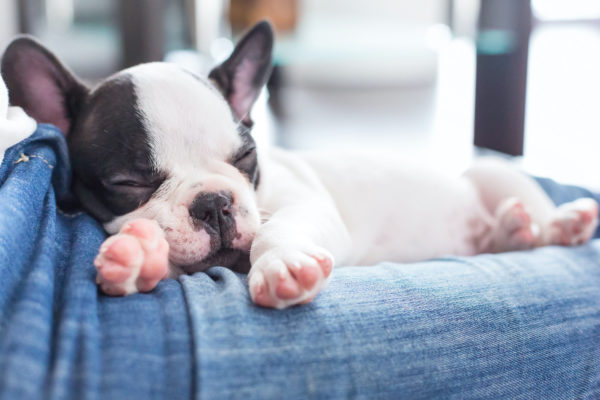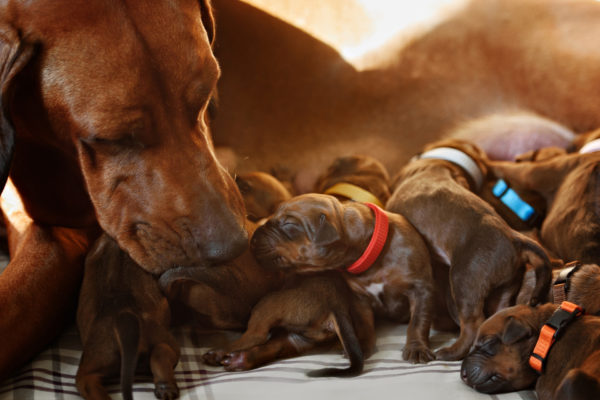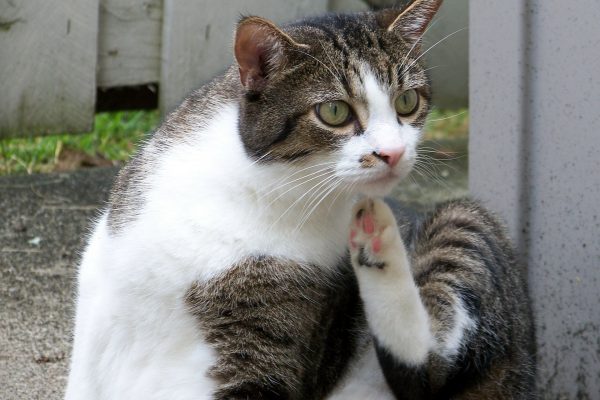PREPARING FOR YOUR DOG’S ARRIVAL
Will your long-awaited dog be officially arriving in your home soon? These first moments with your pet are sure to be a time of wonder and excitement—and to stay etched in your memory. Whether you’re welcoming a puppy or an adult dog into your home, a little preparation will make sure the process comes off without a hitch. Crate, bed, accessories, toys—the list can be long, confusing, and costly. That’s why Globalvet is here to lend a hand. We can help you determine what’s important and what’s not, and how to pick the right items for your dog (while still leaving you room to have fun splurging!).
CRATE
A crate is pretty well essential. With a little work, you can make it a refuge for your dog—a safe space where they can rest or spend some time alone. On the practical side, a crate can also make your dog feel comfortable even when in an unfamiliar setting or when you’re not at home. To choose the right crate for your dog, here’s what you need to know:
- The size should be appropriate to the size of your pet: your dog should be able to sit, lie, and stretch out easily in it.
- Remember that a puppy will soon grow big, so it’s important to keep this in mind, and use a separator if necessary to restrict the space. The separator will be especially useful for house training. Because dogs do not usually do their business where they sleep, restricting their space when you’re with your dog is a good training strategy.
- If your dog is small, consider selecting a crate or carrier that you can easily transport and put in the car when you travel together.
- Fabric, plastic, or metal? It can get quickly overwhelming with all the available options. But remember, the decision is yours. There is no ideal type of material. You may decide to choose a crate that allows your pet to see what is going on around them. This type of crate is more suitable for a puppy, who will no doubt need some comforting when they arrive in their new home!
Wondering how to make sure your new dog takes a liking to its crate and doesn’t view it as torture? Check out our tips and tricks in our article on introducing your pet to a crate.
YOUR DOG’S BED
Setting up resting spots for your pet is essential. Just like your rocking chair in the basement, couch in the living room, and bed in your bedroom, your dog also needs a similar type of spot. Even if you decide to cozy up with your dog around the house, it will still need a bed.
Here’s the perfect place for your dog to sleep or lounge in:
- A bed, cushion, or blanket thick enough to be
- The bed should be large enough so that your dog can fully stretch out.
- Since accidents happen, it’s much more practical to choose a material that is easy to clean or a cushion with a waterproof cover that you can throw in the washing machine.
BOWLS AND INTERACTIVE FEEDERS
Seems simple, right? However, you need to consider a few aspects when purchasing feeding accessories for your dog. You will need to purchase three separate items:
- A water bowl made of stainless steel. Why not plastic? Because plastic can become damaged more easily if your dog has a tendency to bite it, so the damaged parts become more difficult to clean and your dog could swallow the bits that break off. In addition, some dogs develop contact hypersensitivity to various types of plastic. The dog’s nose can become discoloured and irritated, which is something you want to avoid. A ceramic bowl is also an option, although a less resistant one than stainless steel.
- An object in which to hide your dog’s dry food, commonly referred to as an interactive feeder, such as a Kong Wobbler® or Orbee-Tuff Snoop®. When it comes to food, forget about using an ordinary bowl. Interactive feeders are extremely beneficial—not only do they keep your pet busy and mentally stimulated, but they also make your pet eat more slowly!
- An object in which to conceal canned food, such as a Kong Classic® or Aquapaw® Slow Treater®
Why get something for canned food if you’re planning on feeding your dog only dry food?
This item is not only to feed your dog, but also give them a mental workout and satisfy their natural desire to chew. And it’s the perfect activity for your dog when you brush them or trim their nails. You’ll find it very useful. When the time comes, your Globalvet team can draw up a dietary plan that includes only a small portion of canned food so your pet can benefit from this enjoyable activity.
ACCESSORIES FOR THE OUTDOORS
In order to enjoy the great outdoors safely, whether walking your dog in the morning to “do their business” or for longer outings, there are a few things you should include in your starter kit:
- A non-slip collar where you can attach your dog’s ID tag
- A leash about 6 feet long for taking your dog for a walk
- If needed, a walking harness or halter
- A long line (leash) attached to a solid object that allows your dog to be in your yard safely (unless you have a fenced-in yard that your dog cannot get out of). You can also use the long leash when you go walking in the woods, for example, to give your dog more freedom, while ensuring their safety and preventing them from running away.
TOYS
Toys are a must for your dog! Playing with your dog is a great way to build a positive and trusting relationship. You will find a wide array of toys on the market. Here are some tips to help you pick the right ones:
- Refer to the recommended size chart. Many toys list a recommended size, so you can determine whether they’re suitable for your dog or not. If no information is indicated, keep the following in mind:
- Irregular-shaped toys should not be able to fit completely inside your dog’s mouth when closed
- Balls must be twice the size of your dog’s mouth. Toy sizes must follow your dog’s growth.
Here’s an example of a size chart you’ll see on some toys.
- Rubber toys are generally more resistant. Those made by Kong® are known for that!
- Stuffed animals should not have any small items that a dog could rip off and swallow (such as plastic bead eyes).
- All toys should be given to your dog while under your supervision, especially those made of cloth or rope, which are more likely to be ripped up by your dog and partially ingested. Intestinal blockage caused by a piece of stuffed animal won’t be much fun for your pet!
THINGS TO CHEW ON
In addition to interactive feeders, your dog will need things to chew on to satisfy their needs to chew. To ensure your dog’s general wellness and safety, including a healthy weight, gastrointestinal health, and dental health, follow these tips:
- There must be an indication of the caloric content of the item if it is to be ingested (e.g., C.E.T. Enzymatic® oral hygiene chews or Veggiedent®)
- Hardness is important. According to Dr. Fraser Hale, a veterinarian specializing in dentistry, the rule to follow in this respect is quite simple: “If being hit in the kneecap with the object would hurt, then it’s too hard for your dog to chew on.”
- The size of the object must be suitable for the dog’s mouth, so that it cannot be swallowed if indigestible (e.g., rubber toy).
- If the object to be chewed on is meant to be ingested (e.g., rawhide bone and oral hygiene chews), it is important that it be manufactured by a company with a manufacturing process regulated by the FDA (Food and Drug Administration), to prevent the risk of contamination, for instance. It can be difficult to check whether the process used to manufacture the item you wish to purchase is regulated. Feel free to ask the supplier any questions. Does your dog love chewing on a bone down to the very last bite? It’s recommended to take the bone away when its size or texture presents a choking hazard.
- The use of real bones can pose health risks. They frequently cause mouth problems (broken teeth, gum or palate injuries) or gastrointestinal problems (diarrhea, constipation, obstruction). Their use must also involve strict hygiene rules, in order to minimize the risk of microbial contamination, especially if there are young children in the family.
- It’s also useful to give your dog things to chew on with different textures, such as rawhide, rubber, plush fabric, and a braided cord toy.
HYGIENE ACCESSORIES
If you adopt a dog, you will need an ammonia-free cleaner and an odour-neutralizing product such as Uri Clean® or KOE®. You need to be aware that despite your best efforts, your dog will have a few accidents, especially a puppy!
Training pee pads are an essential part of a puppy’s house training. When you’re away, if your dog is left alone for longer than they can physically manage, you’ll need to provide a “bathroom” area.
You will also need small bags to pick up dog poop and dispose of it hygienically. Some bags are even biodegradable! As a good citizen/dog owner, it’s important to pick up after your dog.
GROOMING ACCESSORIES
- Nail clippers
- A comb and/or brush
- A soft-bristle toothbrush and toothpaste designed for pets. Dogs can’t use the same toothpaste as you because it contains fluoride.
You can get some shampoo and ear cleaning products at your first veterinary visit. Your team can advise you on the products best suited to your dog’s skin and fur.
Are you afraid to brush your dog’s teeth or trim its nails? Would you like to know how to provide your dog with the above care? We’ll walk you through the process step by step and provide you with advice.
PRODUCTS TO SETTLE YOUR DOG INTO THEIR NEW HOME
When puppies are with their mothers, they have access to two things that have a calming effect:
- Alpha-casozepine derived from the mother’s milk
- Calming pheromones secreted by glands located near the mother’s teats.
People have come up with ingenious ideas for reproducing these two calming elements produced by the mother and turning them into products available in stores. Recommended products:
- Zylkene®, which includes casein in the form of soft capsules or chewy bites. These can be administered regularly, once a day, during your dog’s first few weeks in your home.
- Adaptil, available as a diffuser and in other forms. To make the transition smoother for your new pet, simply plug the diffuser into an electrical socket 48 hours before your dog’s arrival to release the pheromones.
FOOD AND TREATS
Food and treats are naturally a must! Because nutrition is such a complex topic, your knowledgeable veterinary team is ideally suited to advise you. At your first appointment, your vet will propose various options and answer any questions you may have about your pet’s diet.
Interested in learning more about canine nutrition while awaiting the arrival of the new addition to your family? Our team of professionals shares a wealth of information in the nutrition section.
CONCLUSION
Now that you’ve drawn up a complete list of what you need to buy, you feel better, don’t you? You’re fully prepared—or almost! If you need help with the final details, feel free to contact your veterinary team, who can advise you and recommend products suitable to your pet. Some of these products are even available online now!
Questions about what your pet is going to cost you in the coming months? See our article on budgeting.



